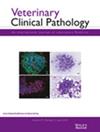Evaluation of coagulation and platelet activation state and function in heartworm-infected dogs
Abstract
Background
Enhanced platelet responses have been demonstrated in heartworm-infected (HWI) dogs; however, the cause and clinical implications of altered platelet function have not been fully elucidated.
Objective
This study evaluated platelet function in HWI dogs.
Methods
Anticoagulated whole blood collected from eight HWI and eight uninfected dogs was evaluated using turbidometric platelet aggregometry, a platelet function analyzer (PFA-100), a total thrombus analysis system (T-TAS), tissue factor-activated and tissue plasminogen activator modified thromboelastography (TF- and tPA-TEG), CBC, von Willebrand Factor activity, and fibrinogen concentrations. Platelet activation state and the presence of reticulated platelets were assessed via flow cytometric expression of P-selection (CD-62P) and thiazole orange staining.
Results
Platelet aggregation responses to adenosine diphosphate (ADP, 10 μM) or collagen (20 μg/mL), PFA-100 closure times, and T-TAS occlusion times did not differ between groups. TEG values TF-R, tPA-R, TF-K, and TF-LY60 were decreased (P = .025, P = .047, P = .038, P = .025) and TF-MA, tPA-MA, TF-G, tPA-G and TF-alpha angle were increased (P < .04) in HWI dogs. HWI dogs had higher fibrinogen concentrations (465.6 ± 161 mg/dL vs 284.5 ± 38 mg/dL, P = .008) and eosinophil counts (0.686 ± 0.27 × 103/μL vs 0.267 ± 0.20 × 103/μL, P = .003). There was no difference in hematocrit, activation state, or percent of reticulated platelets. Non-activated reticulated platelets exhibited higher CD62P expression compared with mature platelets.
Conclusions
Chronic canine heartworm disease was accompanied by hypercoagulability, hyperfibrinogenemia, and decreased fibrinolysis. Enhanced platelet activation was not identified in this group of HWI dogs.


 求助内容:
求助内容: 应助结果提醒方式:
应助结果提醒方式:


